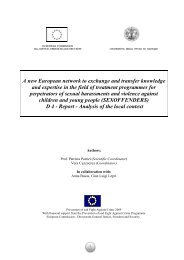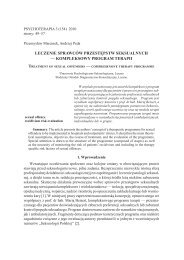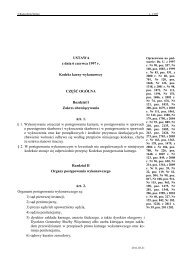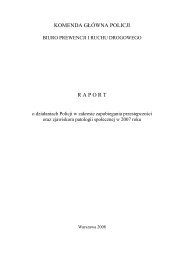ENGLISH
ENGLISH
ENGLISH
- No tags were found...
Create successful ePaper yourself
Turn your PDF publications into a flip-book with our unique Google optimized e-Paper software.
InterventionCentresregionalregionalyesyes3 = personal contact with the victim3 = personal contact with the victim2520ImmigrantWomen’sServicesregionalyes3 = personal contact with the victim; 4 = degree of severity of injuries;5 = other (degree of traumatisation)30SocialServicesregionalyes1 = evidence of the victim from written report; 3 = personal contact with the victim3HealthServicesNetworkregionalnono––––ChildProtectionAuthoritiesMinistryregionalno–––––regionalyes1 = evidence of the victim from written report; 3 = personal contact with the victim15Among the respondents, 4 stated that they used a risk assessment instrument. Of the remaining 11 participants, 5 said thatthey do not know any RAI, 1 said they never needed any, and 4 had other reasons for not applying a RAI, namely that theirmain tasks are coordination, management etc., and therefore they lack direct contact with victims.Of the 4 who use a RAI, 3 have developed their own instrument, and 1 uses the DA by Campbell. In all instances the woman/victim is involved in the assessment process. One organisation developed its own instrument according to the standards ofrisk analysis of the federal conference against forced marriage. In all cases a professional of the agency fulfils the assessmenttask. One respondent added specifically that the assessment is reviewed in a team conference. Another explained that notone, but more people are involved in the assessment process depending on the level of risk:’In every case two workers assess the risk, and if the risk rises to a medium level, then the case is carried up to the supervisor;the greater the danger, the higher the department level that is involved.’With the exception of one regional child protection authority no other respondent could confirm a systematic application of theinstrument. When asked in which cases they decide to apply a RAI, 2 respondents explained:’It depends on the case and the discretion of the case worker whether they apply a risk assessment instrument,’ and ’I useDA if there is severe violence and if there is a necessity based on my own and the victim’s assessment.’The 4 respondents using a RAI found it helpful, mostly because it ’seems to objectify the personal impression which mightor might not be realistic’. Another reason is the awareness of the victim: ’I can tell the woman more easily of what sheshould be afraid of.’Safety planningIn this area the answers are quite devastating and meagre. Just 1/3 (5 out of 15) of respondents could confirm that they havestandards for protection and safety for high risk victims. One regional child protection authority pointed out that ’the standardsconcern the safety and protection of children. Concerning the protection of women, the answer must be No.’ The remaining3 respondents stated that setting up a safety plan is the main standard for the protection of high risk victims, and one addedmulti-agency meetings as a safety measure.P 39






